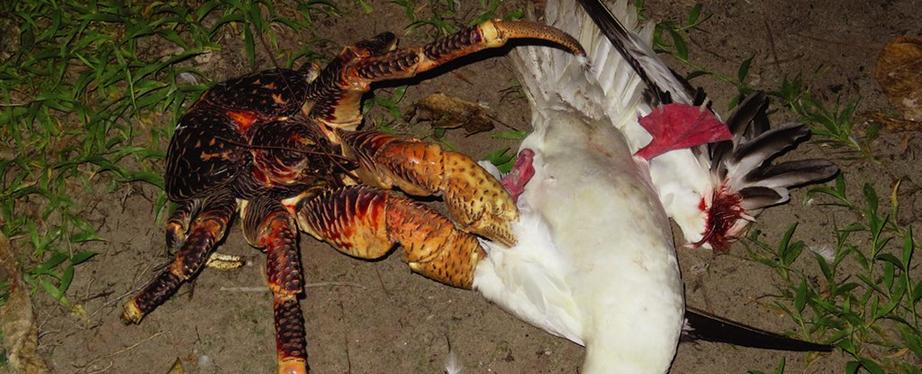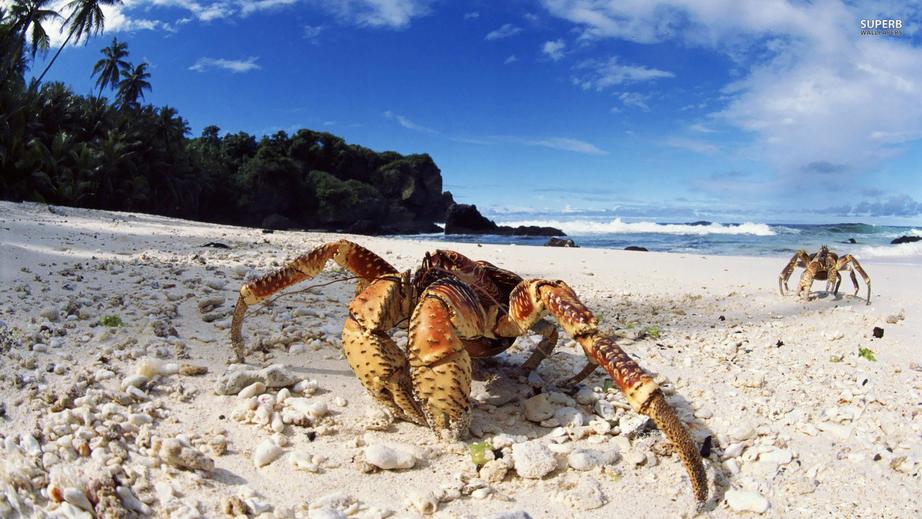Giant coconut crab caught attacking and eating an innocent seabird

Warning: there's a video.
If you find arthropods to be nightmare fuel, this latest finding from the genre of 'abnormally huge animals eating things we didn't expect' will likely ruin your entire weekend.
A coconut crab on a small island in the Indian Ocean has been recorded snatching and devouring an adult seabird - a red-footed booby whose choice to sleep on a low-lying branch proved to be fatal.
Reaching a size of more than one metre (three feet), coconut crabs (Birgus latro) are the largest land-dwelling arthropods in the world.
The sheer expanse of their spidery, armour-clad legs is enough to make them deeply disturbing, but on top of that they're endowed with giant claws that can lift 30 kilograms of weight and pinch with a force of up to 3,300 newtons - comparable to the bite force of a tiger or lion.
The crabs get their name from being so strong they can break open coconuts, and their diet primarily consists of fleshy fruit. But sadly, these crustaceans are not just fruit-eating, island-dwelling hippies.
As omnivores, they will readily eat meat if they can get it, including catching it for themselves - although usually that just means eating a smaller crab or scavenging a dead relative.
Now we have proof that coconut crabs are way, way worse than we could ever imagine. Last year, biologist Mark Laidre from Dartmouth College was studying coconut crabs in the Chagos Archipelago, when one night he recorded a truly gruesome scene.
Laidre watched as a large coconut crab snatched a red-footed booby from where it was sleeping in a low-lying tree branch. The arthropod snapped the bird's wing, rendering it helpless, and held on with its claws as the booby struggled and kicked its feet.
From there, the scene only got more disturbing. Smelling blood from the injured bird, within 20 minutes five other coconut crabs swarmed in, and fighting began over the still-alive prey.
It took them several hours to shred the bird, carrying away the pieces to devour them.
Laidre captured a video of the crab as it was gripping the bird, and it's pretty disturbing to watch, although thankfully the footage cuts off before the feeding frenzy began.
Crazy enough, this isn't the first time a coconut crab has been seen catching a red-footed booby, according to Laidre, who wrote up his findings in a paper published last week. Two years ago, a colleague of his witnessed a bird dragged into a crab's burrow, never to be seen again.
While horrible to watch, the event actually informed Laidre's research. He has been studying the ecology of islands where coconut crabs live, as there's fairly little we know about this giant species.
It looks like the presence of coconut crabs might be influencing bird nesting behaviour on the small islands where both species cohabit. Since coconut crabs can't swim, they don't freely move between islands on the archipelago, so some places have far more of them than others.
And if there's an abundance of the monster crabs on an island, birds don't nest on the ground there, according to Laidre. Which is fair, since we wouldn't go anywhere near the clawed murderbeasts either.
Sure, that's being a little unfair to the crabs, who likely wouldn't hurt a human if they saw one.
"They're not belligerent. They're curious," Laidre told Elaina Zachos at National Geographic. "They're not coming and jumping and trying to attack you. Coconut crabs more should fear humans."
But apart from the graphic evidence that they will eat a bird alive, there's also the incredibly disturbing theory that the reason we haven't found Amelia Earhart's remains is because she was eaten by coconut crabs.
It's probably just a nonsense tale, though. Probably.
The study was published in Frontiers in Ecology and the Environment.

